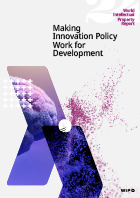The World of Innovation Capabilities
Mapping the world’s knowledge can empower innovation policy makers to make informed decisions.

Knowledge is everywhere in the world. It powers the development of capabilities in every innovation ecosystem. These capabilities represent the ability of an ecosystem to deliver competitive outputs in a certain field of the innovation process. In many cases, knowledge can be embedded in tools, procedures, or articulated in codes that are easily shared around the world. In other cases, knowledge is tacit, meaning is gained from personal experience. Therefore, embedded in individuals’ brain and, not easily codifiable and transferrable. This fact makes understanding and measurement of various capabilities crucial for innovation policymaking. How can they be classified?
Identifying the innovation capabilites
Innovation is a multidimensional force. It encompasses various facets of human endeavor across nations, regions, and industries. Innovation ecosystems thrive on fostering robust interactions between their scientific, technological, and productive sub-ecosystems which involve various stakeholders. Identifying the innovation capabilities across these three interdependent dimensions can characterize the landscape of innovation ecosystems worldwide.
Scientific capabilities include research, discovery, and generation of knowledge. Scientists and researchers push the boundaries of the world’s scientific knowledge by discovering, perfecting, and combining existing capabilities in each scientific field.
Technological capabilities include all the methods that transform existing scientific and technical knowledge into concrete processes and products. Engineers, applied scientists, developers and designers collaborate to bridge the gap between theory and practice. Patents can be a proxy for measuring these types of capabilities.
Production capabilities are those capabilities required for mass production of goods and services commercialized in an economy. This happens at the scale of large corporations, as well as at the scale of small companies and start-ups. International trade data can be a proxy for measuring these types of capabilities.
Why map innovation capabilities?
Assessing the capabilities of these three dimensions is crucial for evidence-based policymaking but is not straightforward. Mapping innovation capabilities can help identify regions or countries that excel in certain areas of innovation, as well as areas where there may be gaps or weaknesses. Some of these regions are increasingly able to produce scientific research at the international level but fail to transform this research into . Other regions can contribute to international but fail to transform that productive capacity into the technological learning that leads to innovation. Such economies and regions can benefit greatly from any guidance on where to focus their limited resources to clear the innovation roadblocks between science, technologies, and production.
Related stories

How can Scrabble guide Policymaking?
The game of Scrabble can shed light on why some countries and regions grow faster than others. It also offers valuable lessons for those striving to catch up. Read more to find out how!

The role of Complexity in Achieving the SDGs
Investing in agricultural innovation is one key to achieving the SDGs. Find out why policymakers should continue to invest in agricultural R&D and create incentives and mechanisms for private sector participation.

